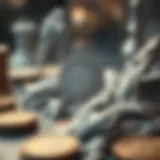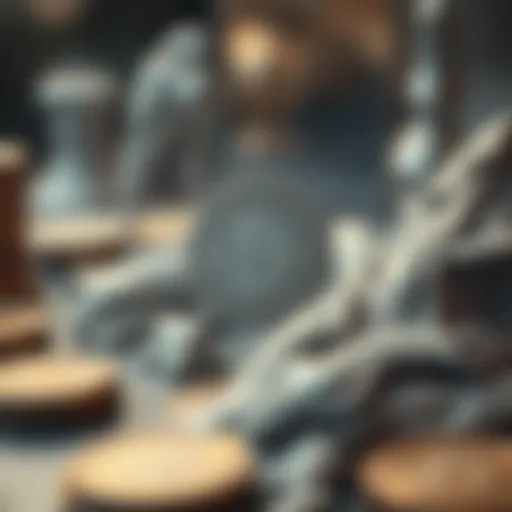Creating NFT Art: A Comprehensive Guide
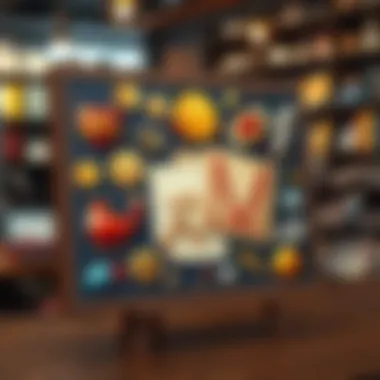

Intro
Navigating the world of NFTs can seem like stepping into uncharted territory for many artists and enthusiasts. With every digital brushstroke potentially being transformed into a unique, tradable asset, understanding the mechanics of this phenomenon is vital. This guide aims to peel back the layers on NFT art creation, offering not only practical steps but also a nuanced understanding of market trends and the landscape in which these digital assets thrive.
As the digital canvas expands, so too do the opportunities and complexities. From dissecting what NFTs truly are, to exploring the tools and platforms that artisans utilize, each section in this narrative will serve as a foothold in climbing the mountain of knowledge required for success in this field. The conversation around NFTs often dances between hype and skepticism, making it even more crucial to be well-informed, whether one is a seasoned creator or simply curious about the digital art revolution.
So put on your digital thinking cap and let’s delve into the universe of NFT art.
Understanding Cryptocurrency Market Trends
Before diving into the nitty-gritty of creating NFT art, it's essential to grasp the cryptocurrency market's pulse. This market isn't just an arbitrary collection of digital dollars; it reflects a community of traders, investors, and artists, each impacting the ebb and flow.
Current Market Analysis
The cryptocurrency market is notorious for its volatility, with values fluctuating quite drastically within short time frames. Recent trends indicate an increased acceptance of NFTs among mainstream consumers and collectors, suggesting that we aren't just witnessing a passing fad. Platforms like OpenSea and Rarible have made the buy-sell interaction as smooth as butter on warm toast.
However, artists must remain cautious. Checking historical price performance can often reveal patterns that might inform future decisions. By comprehending fluctuations and actively observing market behavior, one can strategically create works that resonate with current consumer sentiments.
Historical Performance and Lessons Learned
History has its lessons to teach. Many artists rushed to forge their art into NFTs at the height of the hype, only to find themselves disillusioned as the market cooled. Understanding why certain pieces sold for astronomical amounts while others fell flat can provide crucial insights.
- Example 1: Beeple’s Everydays: The First 5000 Days sold for $69 million, a powerful case study in how a unique concept can capture widespread attention.
- Example 2: Conversely, numerous artists saw their works gather dust in the digital marketplace without the right marketing approach or promotion.
"Market dynamics are not just about the art itself, but the story behind it, the narrative it conveys, and the audience it captures."
By analyzing these highs and lows, aspiring NFT artists can harness information to refine their artistic approach and shrewdly time their releases. Understanding audience psychology is key—after all, art is as much about connection as it is about creativity.
Next up, we will explore practical guides tailored for those looking to invest their time and resources into creating NFT art.
Understanding NFTs
The world of digital art has transformed significantly since the emergence of non-fungible tokens, commonly known as NFTs. Taking the time to understand NFTs is crucial for anyone venturing into this vibrant new arena. By comprehending what NFTs are and their implications in the art world, artists, investors, and technologists can navigate the complexities of this domain more effectively.
NFTs offer a unique opportunity to create, sell, and collect digital art on a decentralized platform, providing artists with financial rewards and ownership rights that are often difficult to secure in traditional mediums. They also open doors to new forms of collaboration and innovation within the creative industries. Thus, grasping the essence of NFTs can enable players in the market to make informed decisions and seize emerging opportunities.
Definition of NFTs
Non-fungible tokens are digital assets that represent ownership or proof of authenticity of a unique item, whether it be digital art, music, videos, or even virtual real estate. Unlike cryptocurrencies, such as Bitcoin or Ethereum, which are interchangeable and can be exchanged for one another (hence "fungible"), each NFT possesses distinct attributes that set it apart. This individuality provides a verifiable digital certificate of ownership tied to the original creation.
To better illustrate this, think of NFTs as a rare trading card compared to baseball cards in general. Even if both are a type of card, each trading card has different rarity values, artwork, and history, making them unique. Similarly, NFTs allow digital assets to have distinct identities, registered on a blockchain, which is a digital ledger providing transparency and security in transactions.
Importance in the Art World
NFTs have brought seismic changes to the art landscape, making it viable for artists to monetize their digital creations which previously could be easily copied and shared without compensation. A few crucial aspects highlight the significance of NFTs in the art world:
- Empowering Artists: Artists can directly sell their work to buyers without intermediaries, retaining a greater share of the profits.
- Provenance Tracking: The blockchain enables a clear chain of ownership, allowing potential buyers to easily verify authenticity and origin.
- New Revenue Streams: Artists can receive royalties automatically whenever the NFT is sold to a new owner, securing ongoing profits from resales.
The shift from traditional galleries and auction houses to online marketplaces means that artists from diverse backgrounds can showcase their work on a global stage, fostering a more inclusive art community.
How NFTs Work
At its core, the mechanics of NFTs hinges on blockchain technology, predominantly Ethereum, that supports the creation and transfer of these tokens. When artists create an NFT, the process is known as minting, where a digital file—be it a painting, photo, or a video—is uploaded to a platform. After the minting process, the artwork gets a unique identifier, recorded on the blockchain, which is accessible to everyone.
This means that any transfer of the NFT—from one owner to another—is transparently recorded and can be traced back to the original artist. Here is a simple outline of how NFTs work:
- Creation: An artist creates a digital artwork and decides to turn it into an NFT through minting.
- Minting: The digital artwork is converted into an NFT using a compatible marketplace or platform, embedding it within a blockchain.
- Sale and Transfer: Once minted, the NFT can be sold and bought, with the transaction recorded, ensuring traceability and authenticity.
- Royalties: The artist can set conditions ensuring they receive a percentage of future sales, establishing an ongoing connection with their work.
Artistic Considerations for NFT Creation
Creating art for non-fungible tokens (NFTs) isn't just about crafting visuals. It involves a blend of creativity, strategy, and technical skills. The artistic considerations form the backbone of your NFT project, impacting its relevance, marketability, and resonance with potential buyers. Here, we delve into critical elements like choosing the medium and developing compelling concepts, as these choices shape the uniqueness and value of your art.
Choosing Your Medium
Selecting the right medium is paramount when creating NFT art. Each medium offers distinct characteristics that can significantly influence your artistic expression and how your work is perceived in the NFT sphere.
Digital Painting
Digital painting stands out due to its versatility and widespread appeal. Artists can easily manipulate colors, experiment with textures, and create layers that are difficult to replicate in traditional media. The primary characteristic of digital painting is that it can blend different styles, from hyper-realistic to abstract, often capturing the attention of a diverse audience.
However, despite its many advantages, digital painting can face challenges, particularly concerning uniqueness. Artists must ensure their work distinguishes itself amidst a crowded market. The ease of reproduction in digital formats can sometimes lead to a perception of devaluation.
3D Modeling
3D modeling is an engaging and dynamic choice for NFT art. This medium allows artists to create immersive pieces that can virtually come to life from all angles. The unique feature of 3D modeling is its ability to incorporate movement and interactivity, enticing viewers into an experience rather than viewing a static image. This can enhance the perceived value of the NFT, as it engages the audience on a deeper level.
On the downside, mastering 3D tools can be a steep learning curve for many creators. Additionally, the file sizes for 3D models can be larger, which may limit some platforms' usability or increase costs.
Photography
Photography, too, has its place in the NFT landscape. It brings the authenticity of the real world into the digital realm, allowing artists to capture and convey emotions in a unique way. The key characteristic of photography as an NFT medium is its ability to tell stories through images, given that each shot has inherent value and can resonate with experiences beyond the visual itself.
While photography can evoke strong responses, one must consider its saturation in the marketplace. Distinguishing one's work in a sea of photography NFTs can be challenging and might require innovative presentation or unique themes to stand out.
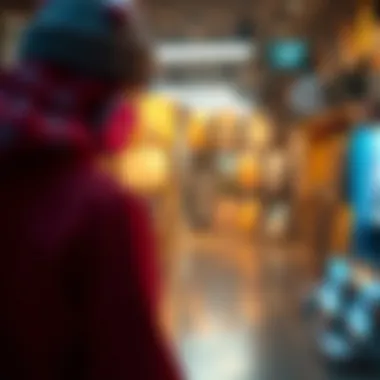

Video Art
Video art makes a compelling case for itself with its capability to integrate sound, movement, and narrative. A key feature of video art is that it has the potential to engage audiences emotionally over time, rather than through a quick glance. This dynamic storytelling aspect can create a lasting impression, significantly impacting an NFT's desirability.
Nonetheless, video art can also bring along technical difficulties, especially regarding rendering and storage. Artists may confront challenges in maintaining quality across different platforms. It’s crucial to think carefully about file formats and playback issues to ensure the final NFT reflects the intended vision.
Concept Development
Once the medium is chosen, the next step in your artistic journey is conceptual development. A well-thought-out concept underpins the entire artwork, providing focus and intention.
Research and Inspiration
The process begins with research and inspiration, which act as catalysts for creative ideas. Gleaning insights from current trends, cultural movements, or even historical references can form the basis of a strong concept. The key here is to synthesize various sources of inspiration, creating something fresh yet rooted in recognizable themes.
With countless artists pouring their hearts into NFT art, being attuned to what resonates will heighten your chances of success. However, relying too heavily on current trends can lead artists to lose their unique voice. Finding a balance between inspiration and originality is essential.
Target Audience Analysis
Understanding your audience is vital in shaping the work. Conducting a target audience analysis provides insights into preferences, trends, and potential market value. Knowing who your likely buyers are influences not just the style you may adopt but also the themes that could resonate with them.
With NFT collectors often belonging to specific communities, tailoring your message and medium can enhance engagement. Yet, one must tread carefully; overly catering to audience expectations might lead to losing genuine artistic authenticity. Striking a balance here can be tricky but rewarding.
Theme Exploration
Theme exploration allows artists to dive into the core of what they wish to communicate. Themes can range from personal narratives to social commentaries, providing depth to the artwork. A well-defined theme can enrich understanding and interpretation, making it more engaging for the viewer.
Nevertheless, finding the right theme may require iterative processes and experimentation. Artists might need to pivot from their initial ideas based on the audience's reception or their creative instincts. The evolving nature of NFTs means flexibility and willingness to adapt is a valuable trait for the artists embarking on this journey.
Tools and Software for Creating NFT Art
In the realm of NFT art creation, the selection of appropriate tools and software is paramount. These resources are essential not just for producing visually appealing artworks but also for ensuring that they conform to the standards necessary for minting and selling NFTs effectively. Artists can choose from a variety of options, each with its own features, strengths, and potential drawbacks. Knowing these details can streamline the process and enhance the overall quality of the artwork.
Graphic Design Software
Adobe Illustrator
Adobe Illustrator stands as a stalwart in the graphic design arena. This vector graphics software is especially handy for artists aiming to create scalable designs that maintain quality regardless of size or format. As an NFT artist, utilizing Illustrator allows for precise control over shapes and lines, making it ideal for detailed illustrations and typography.
One of the key characteristics of Adobe Illustrator is its extensive library of tools and features, such as the powerful pen tool and various brush options. It's quite common to see illustrations crafted in this software selling for thousands in NFT markets. However, it can be a steep learning curve for newcomers, particularly those unfamiliar with design software.
The ability to export files in various formats is a notable advantage, but at times the performance may lag, especially with larger files or overly complex designs.
CorelDRAW
CorelDRAW is another heavyweight contender that deserves mention. Unlike Illustrator, which predominantly focuses on vector art, CorelDRAW has built robust features for layout and print designs. Its intuitive interface often becomes a favorite among artists who are just stepping into the digital art world.
A standout feature of CorelDRAW is its unique ‘LiveSketch’ tool, which allows for real-time vectorization of drawings as they are sketched. This can be beneficial for artists looking to convert traditional sketches into digital art seamlessly. However, some users find that CorelDRAW's pricing model, which can be quite expensive compared to competitors, may deter beginners.
Procreate
For artists who favor working on the go, Procreate is an excellent choice. This app has gained immense popularity amongst digital artists for its user-friendly interface and depth of features that rival some desktop software. Particularly designed for the iPad, Procreate supports Apple Pencil, allowing artists to create stunningly detailed artworks with ease.
A key characteristic of Procreate is its extensive brush library, which can be customized, making it incredibly versatile for various art styles. Artists particularly value the way the app feels like traditional painting while offering all the advantages of digital work. However, it lacks some advanced features found in desktop programs, which may limit complex projects.
Animation and Video Tools
After Effects
Adobe After Effects stands as the go-to program for animation and visual effects for many NFT artists. It allows users to create motion graphics and animations that can bring NFTs to life, making static images more engaging. The layering capabilities of After Effects enable intricate designs that can captivate an audience.
After Effects excels in its integration with other Adobe products, which is a large benefit for those already in the Adobe ecosystem. However, it may feel overwhelming for beginners due to its extensive features and interface complexity, which can steepen the learning curve.
Blender
Blender is a powerful open-source 3D creation suite, gaining traction in the NFT sphere. It encompasses everything from modeling and sculpting to animation and rendering. The versatility means artists can create not just static NFTs but full 3D experiences.
One of the most appealing aspects of Blender is that it's free, which lowers the barrier for entry significantly. However, this open-source nature may lead to variable support and documentation quality, as contributions come from a wide range of users.
Cinema 4D
Cinema 4D is another leading software in 3D design, favored particularly for motion graphics. Its user-friendly interface and powerful performance make it a popular choice among professional designers. Although a premium product with a higher price tag, the sophistication of its features often justifies the investment for artists looking to develop high-quality animations and 3D content.
Notably, Cinema 4D integrates well with other software tools, enhancing workflow efficiency. However, the complexity may pose challenges for those who do not have prior experience in 3D design.
In summation, selecting the right tools and software is a cornerstone for artists venturing into the NFT landscape. Each application offers unique strengths, and understanding these will help in making an informed decision based on individual needs and artistic goals.
Minting Your NFT
Minting your NFT is akin to putting a gold star on your artwork, turning it from a mere digital image into something that carries ownership, value, and a place in the blockchain. In this ever-evolving digital landscape, understanding how to mint an NFT is essential for artists who want to capitalize on their creative works. This process involves converting your digital asset into a non-fungible token, which secures its authenticity and uniqueness, making it possible to buy and sell in marketplaces.
Choosing a Marketplace
Selecting the right marketplace to mint your NFT is crucial as it determines the audience and exposure your work will have. Each platform comes with its own perks, but you need to pick one that resonates with your work.
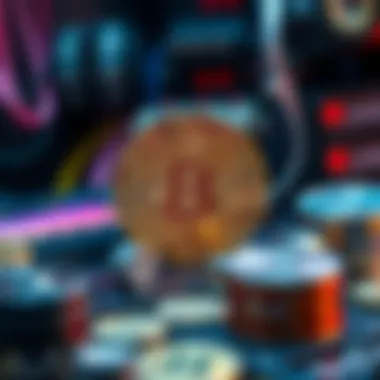

OpenSea
OpenSea is the heavyweight champion when it comes to NFT marketplaces. It boasts a wide array of assets and an easy-to-use interface that helps newcomers and seasoned artists alike. One notable aspect is its user-friendly minting process, which allows artists to create NFTs without needing extensive tech skills.
However, one challenge artists often face is the transaction fees, commonly known as "gas fees," associated with minting on the Ethereum blockchain. While OpenSea provides an extensive reach, artists should weigh the expenses against potential gains, as high fees can eat into profits, especially for low-priced items.
Rarible
Rarible stands out for its community-driven approach, where artists can participate in governance decisions about the platform. This sense of ownership is appealing for creatives who want more than just a place to sell their art. A key feature of Rarible is its royalty structure, allowing artists to earn a percentage of sales whenever their work is resold.
On the downside, the marketplace has been known for fluctuating gas fees, which can suddenly rise, impacting the overall minting cost. This might deter potential buyers if they see high costs at checkout.
Foundation
Foundation takes a more curated approach, often seen as more exclusive, which can be a double-edged sword. It requires artists to be invited to mint their NFTs, giving a sense of prestige but also limiting accessibility. The hallmark of Foundation is its focus on high-quality art, which may appeal to serious collectors looking for unique pieces.
However, the exclusivity can also mean higher competition among artists. It’s important for creators to weigh the benefits of being in a selective environment against the challenge of being visible among a myriad of talented individuals.
Creating a Digital Wallet
Before you can mint your NFT, it's crucial to have a digital wallet capable of holding cryptocurrencies and NFT tokens. This wallet acts as your personal bank in the world of digital art.
Types of Wallets
Digital wallets come in various forms, principally categorized into hot wallets and cold wallets. Hot wallets are connected to the internet and allow for quick transactions, while cold wallets are offline, adding a layer of security. Choosing between the two often hinges on how frequently you plan to make trades.
A significant advantage of hot wallets is their accessibility, making it effortless to buy, sell, and mint NFTs. However, they are prone to hacks. On the other hand, cold wallets provide robust security in safeguarding your assets, albeit at the cost of convenience. Thus, assessing your comfort with risk is paramount.
Setting Up a Wallet
Setting up a digital wallet is straightforward but requires precision. Users typically download a wallet application, create an account, and secure it with a strong password and recovery phrases. An essential characteristic of setting up a wallet is verifying your identity, which adds a layer of compliance with regulations and enhances security.
Despite the straightforward nature of the setup, keeping track of passwords and recovery phrases remains indispensable. If lost, gaining access back to your digital assets can become an uphill battle. That’s why it’s prudent to take notes and keep them encrypted or stored somewhere safe.
Minting NFTs is not just placing a mark on art; it’s about creating a versatile asset that can be traded across the globe, redefining the norms of ownership and value in the art community.
Marketing Your NFT Art
Marketing is a vital part of bringing any artwork to life, especially in the rapidly changing environment of NFTs. It’s not just about showcasing your creations; it’s about weaving a narrative that resonates with your audience. With the right marketing strategies, artists can transform their digital pieces into sought-after investments, drawing attention from collectors and enthusiasts alike. This section will delve into the necessity of marketing your NFT art, outlining various methods and strategic approaches that can significantly uplift your art’s visibility and appeal.
Utilizing Social Media
Building a Community
Building a community around your art can be an artist's most valuable asset in the NFT space. This involves fostering a connection between your audience and your work, allowing individuals to become not just passive viewers, but active participants in your artistic journey. One of the crucial elements in this context is the ability to create an environment where fans feel valued and engaged. Whether it’s through art challenges, behind-the-scenes content, or personal stories, involving your community allows them to connect on a deeper level with your art.
Social media platforms, such as Twitter and Discord, have become popular choices for NFT communities. These platforms allow direct interaction, enabling artists to share updates and gather feedback in real-time. While this dynamic can be beneficial, it also comes with its downsides; managing such communities can be time-consuming and requires consistent engagement. However, the advantages typically outweigh these challenges, as a dedicated community can lead to increased support, loyalty, and ultimately sales of your NFTs.
Engagement Strategies
Engagement strategies are the lifeblood of any successful marketing campaign in the NFT arena. It's not just about promoting your work; it's about creating meaningful interactions that foster relationships. This might include regular posts, interactive polls, or hosting AMAs (Ask Me Anything) sessions on platforms like Reddit. The essence of these strategies lies in their ability to turn a simple viewer into a follower, then eventually a collector.
A key characteristic of effective engagement strategies is consistency. By maintaining a regular posting schedule and being responsive to comments and messages, artists can cultivate an environment that encourages dialogue and participation. Still, it’s essential to balance promotion with genuine interaction, as overly promotional content might alienate your audience. However, building a robust engagement strategy can create a buzz around your work, driving demand and enhancing the overall value of your art.
Collaborations and Partnerships
Working with Influencers
One effective way of amplifying your reach is by collaborating with influencers. This strategy leverages the established followings of influencers who have a vested interest in the NFT space. By engaging with these key figures, artists can gain access to a broader audience that is already predisposed to appreciating digital art.
An appealing aspect of working with influencers is the authenticity it brings. Their endorsement can carry weight, making your work appear more credible to potential collectors. However, it’s essential to choose influencers whose values align with yours; otherwise, the partnership might come off as inauthentic. The challenge here lies in navigating this process and ensuring mutual benefit. Still, a well-executed collaboration can provide artists with a significant boost in visibility and engagement, potentially leading to increased sales.
Joint Launches
Joint launches represent another innovative method of marketing your NFT art. This involves partnering with other artists or brands to release collaborative works that can draw attention from both audiences. The key characteristic of joint launches is the element of cross-promotion. Both parties can share their collective follower base, multiplying exposure and niche engagement.
While joint launches have the potential to reach a wider audience, they also require careful planning and clear communication; the success of such collaborations hinges on the alignment of creative vision. Moreover, there’s a risk that if one party does not effectively promote the launch, it can affect the overall performance. Nonetheless, if done right, joint launches can greatly expand your reach, making your NFT art more approachable to diverse buyer groups.
Legal Considerations for NFT Artists
As the digital world continues to evolve, artists venturing into the realm of NFTs must grapple with the legal landscape that accompanies this modern form of artistic expression. Navigating copyright, licensing, and tax implications related to NFT art is essential. This section sheds light on various legal considerations, ensuring creators can safeguard their artwork and mitigate potential disputes.
Copyright Issues
Intellectual Property Rights
At the core lies Intellectual Property Rights— a legal framework that secures the rights of creators to their original works. As an artist, understanding these rights is vital. They grant you control over how your art is used, ensuring that you can make decisions against unauthorized uses.
The distinct characteristic of intellectual property rights is their adaptability across multiple platforms. In the world of NFTs, these rights ensure that your creation maintains its value and integrity. One key benefit is the ability to assert ownership over your creations. If someone tries to use your NFT without permission, you have legal avenues to address the infringement.
However, it is prudent to be aware that enforcement can be a double-edged sword. Painting your canvas can be unexpectedly complicated, as proving ownership may require meticulous documentation of your creation process. Therefore, retaining records and understanding your rights is a must.
Licensing Your Work
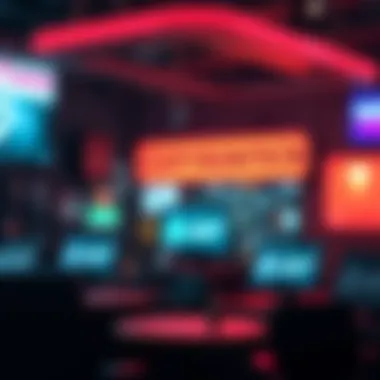

Licensing Your Work encompasses a crucial element of monetizing NFT art. By providing licenses, you can delineate how others may use your work, from resale terms to the broadcasting of your art in virtual spaces. This mechanism offers a blend of control and revenue streams.
One notable benefit of this licensing framework is the financial flexibility it provides. For instance, artists can sell specific rights while retaining ownership, allowing them to earn from their creations multiple times over. This is analogous to splitting revenue streams, which can even breathe new life into older works.
Yet, licensing is not without its caveats. The complexity of drafting effective licenses often requires legal expertise, which may involve costs that some artists are not prepared to incur. Therefore, weighing options and perhaps consulting a legal professional is advisable, particularly when dealing with high-stakes art.
Tax Implications
Understanding Tax Liabilities
Understanding Tax Liabilities is an often overlooked but vital realm for NFT artists. Depending on your country and local regulations, NFT transactions can trigger various tax obligations. Recognizing these liabilities ensures you’re not caught off guard when tax season rolls around.
A key characteristic of taxation in the NFT space revolves around treating these assets as capital gains, which could significantly impact your earnings. Keeping abreast of current rules related to digital assets gives you the edge, allowing for informed decisions regarding sale and trade.
A unique feature to note is that some jurisdictions may offer favorable tax treatment for digital art. However, the flip side is that the lack of clarity in regulations can introduce risks, leading to potential disputes with tax authorities. Thus, continually educating yourself on tax laws relevant to NFTs is critical.
Keeping Records
Keeping Records serves as the backbone of both tax compliance and legal protection. For NFT artists, tracking sales, licenses, and correspondence related to your art can fortify your position in any legal disputes or tax evaluations. Proper record-keeping is akin to having your ducks in a row—essential for upholding your rights.
The significance of maintaining thorough records extends beyond mere compliance; it enhances your professional reputation. Potential buyers or collaborators may trust an artist who can transparently show proof of their works and transactions.
However, the unique downside is that managing meticulous records can become a daunting task, especially for artists burgeoning in their careers. This juggling act may require you to invest time or even enlist help, which could strain resources early on in your journey. Hence, consider utilizing digital tools or services designed to streamline this process.
Maintaining a clarity in your affairs not only protects you legally but enhances your credibility as an artist—this is priceless in the NFT realm.
By understanding these legal aspects, NFT artists position themselves better within the market landscape, safeguarding their creative efforts while enabling them to make the most of their artistic pursuits.
Navigating the NFT Landscape
To thrive in the world of NFT art, it’s crucial to grasp the ever-evolving landscape that surrounds it. This section delves into the dynamics of trends and market analysis, providing artists and investors with the tools they need to navigate successfully through this vibrant, albeit volatile, ecosystem.
Trends and Market Analysis
The NFT market has experienced meteoric growth over the last few years, capturing the attention of artists, investors, and collectors alike. Understanding the current trends is not just beneficial; it’s essential for anyone looking to make their mark in this space.
"Art is not what you see, but what you make others see." – Edgar Degas
This aphorism rings particularly true in the NFT domain, where innovation often leads the charge. Keeping an eye on market developments not only offers insights into what is popular, but also informs potential future trends.
Current Trends
- Diversification of Content:
- Community Engagement:
- Sustainability Initiatives:
- Mainstream Collaborations:
- While traditional digital art continues to dominate, creators are branching into music, virtual reality, and interactive experiences.
- Projects that foster community—through Discord channels or social media—tend to generate more interest and higher value.
- As awareness grows regarding the environmental impact of blockchain technology, many artists are seeking eco-friendly platforms, moving toward greener solutions like Tezos or Flow.
- Collaborations with well-known brands or celebrities help in reaching wider audiences, elevating the value of the art.
Markets can shift overnight, so it’s prudent to stay informed through platforms like Reddit or Twitter. Keeping a finger on the pulse of relevant forums can be a goldmine for emerging insights.
Building a Strong Portfolio
A well-crafted portfolio is the cornerstone of success for any artist in the NFT realm. Art is a personal expression, but in a saturated market, the way you present it can make or break your presence.
- Curate Thoughtfully: Select a range of pieces that showcase your versatility while remaining true to your style.
- Include Rarity: NFTs are often valued based on scarcity. Highlighting limited editions in your portfolio can capture attention.
- Document Your Process: Share videos or behind-the-scenes glimpses of your creation process. Viewers appreciate authenticity and the story behind the art.
- Optimize Details: Make sure each piece has a thorough description and relevant tags. Using keywords strategically can enhance visibility within marketplaces and search engines alike.
In this section, we’ve touched on just the surface of what it means to navigate the NFT landscape. As the market evolves and changes shape, continued research and adaptation places you ahead of the curve.
Future of NFT Art
The future of NFT art stands as a shadow of promise and potential, beckoning artists, investors, and tech enthusiasts into an evolving realm. Understanding this trajectory isn't just about keeping pace with trends; it’s about anticipating shifts that could redefine the landscape of creativity and ownership.
Potential Developments in Technology
The technological advancements around NFTs are like a double-edged sword. They can either propel the medium into a new era or create chasms of disparity. With the integration of blockchain technology evolving, we can expect several significant developments. New blockchain frameworks are being discussed that aim to provide more efficient and energy-friendly solutions, potentially lowering the environmental impact associated with NFT minting.
Moreover, augmented reality (AR) and virtual reality (VR) are likely to play transformative roles. Imagine being in a virtual gallery where NFT art isn’t just displayed but interacts with viewers. This can facilitate a multi-sensory experience, blurring the line between traditional exhibitions and digital showcases. The use of artificial intelligence might also foster a renaissance of creativity. Artists can utilize AI tools for generating unique pieces, pushing boundaries on what constitutes authorship.
Points to consider include:
- Interoperability: Future platforms might ensure collectibles can be used across different ecosystems, enhancing value and accessibility.
- Layered NFTs: Crafting NFTs with multiple interactive layers, allowing for evolving art that can change based on conditions, such as viewer interaction.
"The future belongs to those who believe in the beauty of their dreams." -- Eleanor Roosevelt
As the technology advances, the financial ecosystem surrounding NFTs will likely shift as well. New investment vehicles such as fractional ownership may emerge, allowing a larger audience to engage in the ownership of high-value NFTs without sinking their entire fortune into a single piece. It raises intriguing questions about analytics, valuation models, and market behavior—essential for investors keeping a close eye on the NFT marketplace.
Impact on Traditional Art Forms
The emergence of NFT art isn't merely an addition to the existing canvas; it’s a transformative influence that could alter the fabric of traditional art. Artists who once relied solely on galleries now have robust platforms to reach a global audience directly.
Notably, artists like Beeple and Pak paved the way, causing ripples in the traditional art world by selling their works for millions. As conventional galleries grapple with the competition from digital marketplaces, they may either adapt or risk obsolescence. This shift can lead to a more democratized art space where artists maintain greater control over their rights and royalties.
Furthermore, with the rise of NFTs, the concept of art ownership is being reinvented. Buyers are not just purchasing a static piece of art; they are procuring a unique digital certificate of authenticity. This can potentially diminish the market dominance of traditional auction houses, forcing them to rethink how they operate in a world where everything can be tokenized.
Consider some of the repercussions of this shift:
- Art consumption: With more affordable ways to own digital art, accessibility grows, altering who can partake in the art market.
- Cultural impact: Artists from varied backgrounds can find their voices amplified through this medium, fostering diversity and new narratives that were previously sidelined.
- Monetization: Reimagining the ways artists can make money, including royalties on secondary sales, offers a sustainable income model that traditional art sales lack.
In summary, the future of NFT art is a dance of technology and tradition, one that prompts society to re-evaluate the value placed on creativity, authenticity, and ownership. Keeping an eye on these trends will be crucial for anyone involved in the realms of art, investment, or technology.




